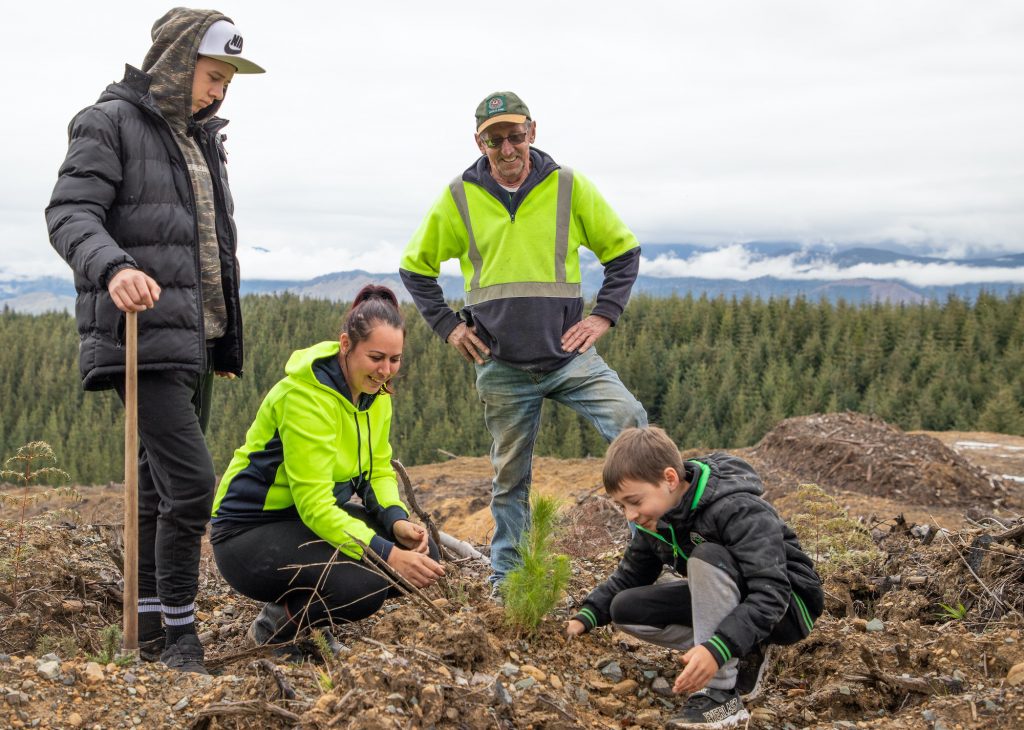
BY CATHIE BELL | PHOTOGRAPHY MARK FORWARD
It’s a stunning day up on the ridges of Coronation Forest in Golden Downs, south of Richmond. There’s a lot of chatter as 74 school children aged 10 and 11 gather to begin a day’s activities in the forest.
Coronation Forest has a long-standing connection with the Nelson Tasman community. The forest is run by Nelson Forests Ltd, and each year in September, the company hosts about 300 children across a week to plant seedlings, understand the relationship between indigenous forest and plantation forest, and learn about how a plantation forest works.
It’s the 65th year of planting at Coronation Forest, and now there are children taking part whose parents and grandparents took part when they were their age. When Nelson Forests’ Heather Arnold asks if any of the parents supervising took part, half the adults there raise their hands.
And it’s not just the parent-helpers – one of the forestry staff supervising is Barry Walsh. He remembers planting trees at Coronation Forest when he was at Waimea Intermediate School. His son took part in planting while at school and is now working in a harvesting crew on the next hill over. Barry’s daughter-in-law Saraya Walsh also works in forestry and is at the school event supervising. His grandson came with his school group this year to take part.
Intergenerational forest
Coronation Forest was the idea of Arnold Cork, who was the Senior Agricultural Instructor for the Nelson Education Board in the early 1950s, Heather Arnold says.
“He realised that forestry was destined to play a major role in the New Zealand economy and thought that the best way for children to appreciate this was for them to be involved in their own forest,” says Heather.
In 1953 schools were given a supply of tree seeds to establish their own small nurseries to raise seedlings and supply tree stocks for planting the following year. As the seedlings were grown during the year that Queen Elizabeth II was crowned, the forest was named Coronation Forest.
The seedlings were then planted in Coronation Forest in 1954, covering six hectares. Douglas-fir seedlings were planted by 712 children from 20 schools across the Nelson Tasman region. Since then, planting at Coronation Forest has occurred every year.
Heather Arnold says there were many Coronation Forests set up nationally, but she thinks that Golden Downs is the only one still active.
“Nelson Forests’ staff and contractors look forward to the event each year, with the workers involved volunteering to be part of the day, running activities and acting as guides for each school group as well as cooking sausages and preparing hot chocolate for the children.”
It’s a popular event, not just with the children.
Barry Walsh has retired from forestry work, but comes back each year for the planting.
He says the children do well with their planting – they are put into groups of three and are given 10 seedlings to plant in a set area.
“They take their time with it, but they make a good job … they all get into it.”
The children plant a certain area, and then contractors come in to finish planting the full area. In 12 months’ time, the seedlings will have grown as high as the children are tall, Barry Walsh says.
Educational experience
Another retired forestry worker who keeps coming back is Rex Marshall. He takes the children through a block of protected indigenous trees within the forest, and teaches them about different plants, insects, and birds in the area.
His tour ends with the children nibbling on a horopito leaf, the unexpected spiciness of that remaining in the children’s memory of the day.
The third activity takes the children to a block of trees that will be harvested in coming weeks. There, they count and measure different trees, noting what the trunks are like and calculating which trees are more valuable than others.
After watching Brightwater School Year 6 students take part in the day, it’s easy to see why they recommend it to others. From that, you could anticipate that it will be a popular event for years to come.
